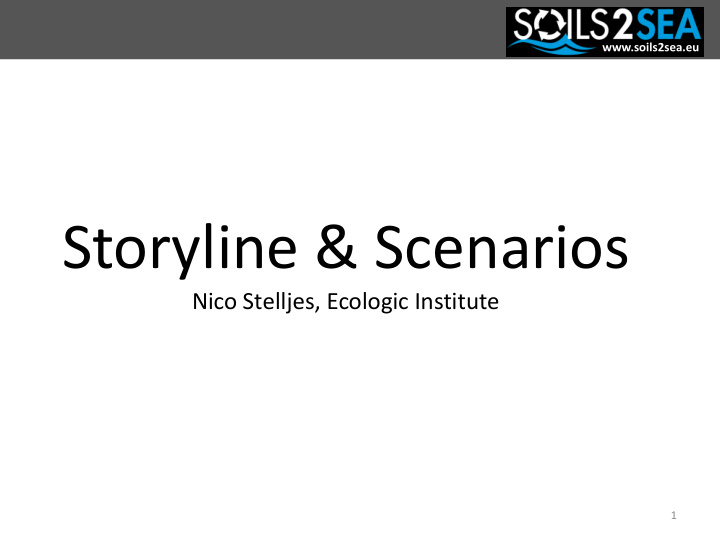



www.soils2sea.eu Storyline & Scenarios Nico Stelljes, Ecologic Institute 1
www.soils2sea.eu 1. Round of workshop in 2014 First set of Workshop were in: • Denmark • Sweden • Poland Focus: Measures 2
www.soils2sea.eu 2. Round of Workshops 2. round of workshops in autumn 2016 • Poland • Sweden • Denmark Focus: Scenarious und Storyline 3
www.soils2sea.eu Spatially differentiated measures Reduction of N varies with factors like soil-type, soil depth, slope and how much tile drainage there is. If the retention is high, lower amounts of N reach the stream. Spatially differentiated measures (like different amount of N used, placement of wetlands, land-use) can help nitrate reduction 4
www.soils2sea.eu Spatially differentiated measures II • In the Norsminde and Odense catchment area (Soils2Sea Case Study area in Denmark), 10- 20% extra nitrate reduction can be obtained in the subsurface through optimal spatial location of crops. 5
www.soils2sea.eu Retention maps • Retention maps estimate the N-transport and N-retention based on models and observation data. • Retention maps can be one tool to exploit potential of spatially targeted measures. • To achieve the best results, retention maps with a fine spatial resolution (1- 25 ha) are necessary. • The level on uncertainty rises with the resolution (= is the map showing real conditions) • In Denmark currently retention maps at around 1500 km2 resolution are used – they cancel out almost all economic and environmental gains of a spatially differentiated approach. 6
www.soils2sea.eu Retention maps Very difficult to Easier to produce produce Low resolution (15km 2 ) RETENTION MAPS High resolution (1ha) High effect of Low effect of differentiated differentiated regulation regulation Uncertainty level of Uncertainty level of accuracy of map = high accuracy of map = low 7
www.soils2sea.eu Methods World Café • Table 1: ‘Centralised’ context • Table 2: flexible management • Table 3: self-governance 8
www.soils2sea.eu ‘ Centralised ’ context In the ‘ Centralised ’ context, the State makes all decisions on the use of measures, including fertilisation norms , at farm or field level. The government uses retention maps at a low resolution (e.g.15km 2 ) to produce spatially differentiated regulations for land-use. This differentiation can increase the effectiveness of catch-crops, constructed wetlands, and help to define fertilisation norms. Government monitors at large catchment level to evaluate if N reduction targets to coastal waters are met. To monitor and control implementation, farmers are required to report detailed plans for cropping systems and fertilisation. Farmers fulfilling the government requirements receive subsidies from the EU CAP. . 9
www.soils2sea.eu ‘flexible management ’ Under the ‘ flexible management ’ scenario, authorities and farmers work together to reduce N emissions through a market- based ‘ cap and trade ’ system. All farmers are obliged to participate . Based on retention maps with relatively high resolution (e.g. 25 ha), permits for N loading are distributed on a field basis. The community of farmers can trade N load allowances amongst themselves . To document compliance each farmer reports with detailed plans for cropping systems and fertilization. Non-compliance with individual allowances is sanctioned . Government authorities can intervene in the market by buying up or selling permits. The government performs control monitoring at catchment level to evaluate if the reduction targets to the coastal waters are achieved. 10
www.soils2sea.eu „ self- governace“ The ‘ self- governance’ approach describes a low level of State involvement. Farmers in the catchment self-organize , (e.g. forming a water council) to decide on measures to reach government-set targets. Detailed retention maps - at 1 ha resolution - can be used by farmers as a tool for spatially differentiated management. A system of self-monitoring is established. Authorities provide financial and technical support and information (e.g. establishing a water council with a technical support, detailed retention maps, monitoring process support). The authorities will monitor only the entire catchment at the outlet. Subsidies are based on reaching the target loads for the entire catchment and their distribution is negotiated between the farmers. If farmers/water council cannot agree , a central regulation based on Scenario A is imposed. 11
www.soils2sea.eu MoSCoW • M - MUST (necessary, essential, and not for discussion) • S - SHOULD (should be addressed, if all MUST- requirements can still be achieved) • C - COULD / nice to have (could be implemented/addressed, but only if items above are not hindered) • W - WON'T (not of interest now/ could be addressed at a later stage) 12
www.soils2sea.eu www.soils2sea.eu Thank you! For more visit: www.soils2sea.eu Soils2Sea has received funding from BONUS (Art 185) funded jointly from the European Union’s Seventh Programme for research, technological development and demonstration, and from Baltic Sea national funding institutions.
Recommend
More recommend